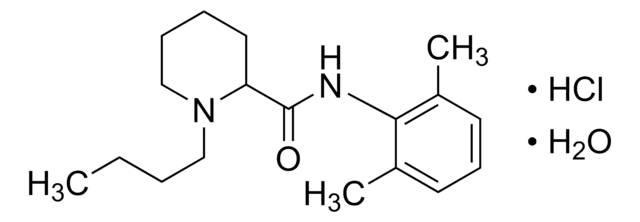PHR1756
Bupivacaine Related Compound B
Pharmaceutical Secondary Standard; Certified Reference Material
Synonym(s):
Desbutylbupivacaine, (2RS)-N-(2,6-dimethylphenyl)piperidine-2-carboxamide, (RS)-N-(2,6-Dimethylphenyl)piperidine-2-carboxamide
About This Item
Recommended Products
grade
certified reference material
pharmaceutical secondary standard
Quality Level
Agency
traceable to Ph. Eur. Y0000088
traceable to USP 1078529
API family
bupivacaine
CofA
current certificate can be downloaded
packaging
pkg of 20 mg
technique(s)
HPLC: suitable
gas chromatography (GC): suitable
application(s)
pharmaceutical (small molecule)
format
neat
storage temp.
2-8°C
SMILES string
O=C(NC1=C(C)C=CC=C1C)C2NCCCC2
InChI
1S/C14H20N2O/c1-10-6-5-7-11(2)13(10)16-14(17)12-8-3-4-9-15-12/h5-7,12,15H,3-4,8-9H2,1-2H3,(H,16,17)
InChI key
SILRCGDPZGQJOQ-UHFFFAOYSA-N
Looking for similar products? Visit Product Comparison Guide
General description
Bupivacaine Related Compound B is formed in the liver during oxidative dealkylation of bupivacaine hydrochloride and is the main metabolite of bupivacaine. It is a local anesthetic agent that can cross biological membranes due to its lipid-soluble nature.
Application
Analysis Note
Other Notes
Footnote
related product
Signal Word
Danger
Hazard Statements
Precautionary Statements
Hazard Classifications
Acute Tox. 3 Oral
Storage Class Code
6.1C - Combustible acute toxic Cat.3 / toxic compounds or compounds which causing chronic effects
WGK
WGK 1
Flash Point(F)
Not applicable
Flash Point(C)
Not applicable
Choose from one of the most recent versions:
Certificates of Analysis (COA)
It looks like we've run into a problem, but you can still download Certificates of Analysis from our Documents section.
If you need assistance, please contact Customer Support.
Already Own This Product?
Find documentation for the products that you have recently purchased in the Document Library.
Our team of scientists has experience in all areas of research including Life Science, Material Science, Chemical Synthesis, Chromatography, Analytical and many others.
Contact Technical Service





